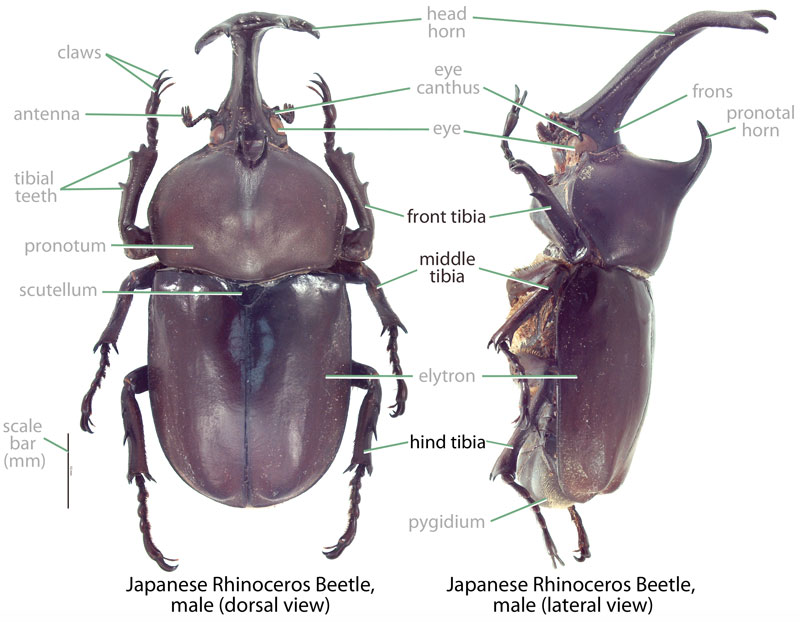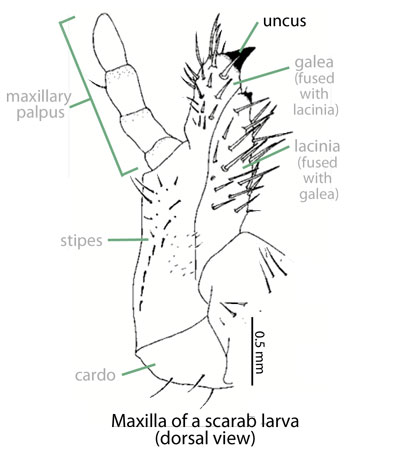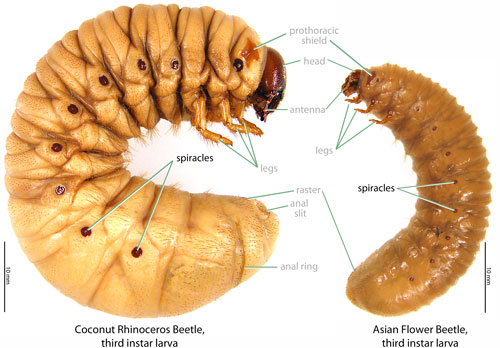Potential Invader
green chafer, white-haired leaf chafer
Family: Scarabaeidae Subfamily: Rutelinae Genus: Anomala Species: Anomala albopilosa (Hope, 1839)
none available
Total body length 15.0–26.0 mm (0.59–1.02 in). Body shape ovate. Color rich green, slightly shiny; rarely reddish or olive colored. Front tibiatibia:
a segment of the leg articulated with the tarsus and femur
 with two external teeth; apical toothtooth:
with two external teeth; apical toothtooth:
a pointed process from an appendage or margin, often in reference to the tibia
long and slightly decurveddecurved:
bending downward
in female (may be worn in older specimens), often shorter in male; basal toothtooth:
a pointed process from an appendage or margin, often in reference to the tibia
evident in male and female. Front inner claw bifurcatebifurcate:
a process dividing into two points
; bifurcatebifurcate:
a process dividing into two points
claw weakly sinuatesinuate:
gently curved (specifically of margins or edges); often in reference to the clypeus
in male, simple in female. Hind tibiatibia:
a segment of the leg articulated with the tarsus and femur
 with inner margin simple, not greatly dilated at the middle.
with inner margin simple, not greatly dilated at the middle.
Undescribed. For Anomala (Ritcher, 1966Ritcher, 1966:
Ritcher P. 1966. White grubs and their allies: a study of North American scarabaeoid larvae. Oregon State University Monographs, Studies in Entomology 4: 1-219.): Grub C-shaped, not hump-backed, cylindrical, whitish. Lacinialacinia:
inner portion of the maxilla of maxillamaxilla:
of maxillamaxilla:
set of paired mouthparts located posterior to the mandibles
with 2 apical unciunci:
in scarab larvae, a hooked process on the distal margin of the maxilla
 equal in size. Maxillary stridulatory area with 4–7 sharp, recurvedrecurved:
equal in size. Maxillary stridulatory area with 4–7 sharp, recurvedrecurved:
bending backwards
teeth. Epipharynxepipharynx:
lobe on the interior surface of the labrum or clypeus
with 2–4 prominent heliheli:
in scarab larvae, a coarse spine on or near the haptomerum
. Final antennal segment with single dorsaldorsal:
of or relating to the upper surface; opposite of ventral
sensory spot. Spiraclesspiracles:
opening on the abdomen or thorax through which air enters and exits the body
 on abdominal segments 7 and 8 similar in size and conspicuously larger than spiraclesspiracles:
on abdominal segments 7 and 8 similar in size and conspicuously larger than spiraclesspiracles:
opening on the abdomen or thorax through which air enters and exits the body
 on abdominal segments 1–6. Anal slit transversetransverse:
on abdominal segments 1–6. Anal slit transversetransverse:
extending horizontally across a surface
, arcuatearcuate:
curved, arched, or bow-shaped
; bordered by several irregular rows of stout setaesetae:
small, hair-like structure
. Lower anal lip bearing patch of 13 hamatehamate:
hook-like in shape
setae.
East Asia. This scarab is known from the four major islands of Japan (Kysushu, Shikoku, Honshu, and Hokkaido) (Kobayashi and Matsumoto, 2011Kobayashi and Matsumoto, 2011:
Kobayashi H and Matsumoto T. 2011. Atlas of Japanese Scarabaeoidea. Volume 2 Phytophagous Group I. Roppon-Ashi Entomological Books, Tokyo, Japan.), the Ryuku Islands, Korea, and Taiwan (Arakaki et al., 2015Arakaki et al., 2015:
Arakaki N, Nagayama A, Shimizu Y, Yara K. 2015. Suppression of green chafer Anomala albopilosa (Coleoptera: Scarabaeidae) populations by mass trapping with light traps. Journal of Applied Entomology and Zoology Online Publication DOI: 10.1007/s13355-015-0333-z).
The larvaelarvae:
the immature form of an insect; in scarabs, also called grub or white grub; preceded by the egg stage, followed by the pupal stage
 of this species feed on the roots of kenaf (Hibiscus cannabinus) (Hiramatsu et al., 2001Hiramatsu et al., 2001:
of this species feed on the roots of kenaf (Hibiscus cannabinus) (Hiramatsu et al., 2001Hiramatsu et al., 2001:
Hiramatsu A, Sakamaki Y, Kusigemati K. 2001. A list of pest-insects feeding on the kenaf in Kagoshima City with seasonal abundance of some major pest-insects. Bulletin of the Faculty of Agriculture, Kagoshima University 51: 1-7.), pines (Pinus spp.) (Nitto and Taohibana, 1955Nitto and Taohibana, 1955:
Nitto M and Taohibana K. 1955. Decision of the number of instar and generation by means of measurements on the larval head, of May-beetle. Journal of the Japanese Forestry Society 37: 326-333. [In Japanese]), sweet potatoes (Ipomoea batatu), and sugarcane (Saccharum officinarum) (Arakaki et al., 2015Arakaki et al., 2015:
Arakaki N, Nagayama A, Shimizu Y, Yara K. 2015. Suppression of green chafer Anomala albopilosa (Coleoptera: Scarabaeidae) populations by mass trapping with light traps. Journal of Applied Entomology and Zoology Online Publication DOI: 10.1007/s13355-015-0333-z).
(Arakaki et al., 2015Arakaki et al., 2015:
Arakaki N, Nagayama A, Shimizu Y, Yara K. 2015. Suppression of green chafer Anomala albopilosa (Coleoptera: Scarabaeidae) populations by mass trapping with light traps. Journal of Applied Entomology and Zoology Online Publication DOI: 10.1007/s13355-015-0333-z): This species has one generation per year, and adults emerge from May to late July. Eggs are deposited in soil by June. First instarinstar:
in scarabs, one of the three larval growth phases (i.e., first instar, second instar, third instar), each ending with the larvae molting to the next phase
larvae emerge by July and third instars by October. Overwintering occurs in the third instarinstar:
in scarabs, one of the three larval growth phases (i.e., first instar, second instar, third instar), each ending with the larvae molting to the next phase
, and pupation usually begins by May. LarvaeLarvae:
the immature form of an insect; in scarabs, also called grub or white grub; preceded by the egg stage, followed by the pupal stage
 live in soil and feed on the roots of several plant species.
live in soil and feed on the roots of several plant species.
Significant. In Japan, larvaelarvae:
the immature form of an insect; in scarabs, also called grub or white grub; preceded by the egg stage, followed by the pupal stage
 of this scarab are known pests (Arakaki et al., 2015Arakaki et al., 2015:
of this scarab are known pests (Arakaki et al., 2015Arakaki et al., 2015:
Arakaki N, Nagayama A, Shimizu Y, Yara K. 2015. Suppression of green chafer Anomala albopilosa (Coleoptera: Scarabaeidae) populations by mass trapping with light traps. Journal of Applied Entomology and Zoology Online Publication DOI: 10.1007/s13355-015-0333-z). In the Ryuku Islands, Anomala albopilosa is a particularly significant pest of sugarcane with periodic outbreaks causing severe damage to sugarcane production of Okinawa (Arakaki et al., 2015Arakaki et al., 2015:
Arakaki N, Nagayama A, Shimizu Y, Yara K. 2015. Suppression of green chafer Anomala albopilosa (Coleoptera: Scarabaeidae) populations by mass trapping with light traps. Journal of Applied Entomology and Zoology Online Publication DOI: 10.1007/s13355-015-0333-z).
Recorded, not established. This species has been recorded in Hawaii at least twice, with records from 1955-56 and 1971-72 (USDA, 1957USDA, 1957:
Anonymous. 1957. List of intercepted plant pests, 1956 (pests recorded from July 1, 1955, through June 30, 1956). United States Department of Agriculture, Plant Quarantine Division. Hyattsville, Maryland, USA; USDA, 1974USDA, 1974:
Anonymous. 1974. List of intercepted plant pests, 1972 (pests recorded from July 1, 1971, through June 30, 1972). United States Department of Agriculture, Plant Quarantine Division. Hyattsville, Maryland, USA). In both cases specimens were found on aircraft flying into Hawaii from Japan.
Not established or recorded. There are no records of this species from Guam.
This species is attracted to lights at night, and it is likely that it would be attracted to well-lit ports and airports. This would allow for hitchhiking on marine or air cargo. Indeed, this species has entered Hawaii at least twice aboard aircraft (USDA, 1957USDA, 1957:
Anonymous. 1957. List of intercepted plant pests, 1956 (pests recorded from July 1, 1955, through June 30, 1956). United States Department of Agriculture, Plant Quarantine Division. Hyattsville, Maryland, USA; USDA, 1974USDA, 1974:
Anonymous. 1974. List of intercepted plant pests, 1972 (pests recorded from July 1, 1971, through June 30, 1972). United States Department of Agriculture, Plant Quarantine Division. Hyattsville, Maryland, USA).
Anomala albopilosa is one of five Anomala species recorded from Hawaii and Guam, along with Anomala orientalis, Anomala sulcatula, Anomala viridana, and Anomala cuprea. It can be separated from the other species by examination of the bifurcatebifurcate:
a process dividing into two points
male front claw (weakly sinuatesinuate:
gently curved (specifically of margins or edges); often in reference to the clypeus
in A. albopilosa versus strongly sinuatesinuate:
gently curved (specifically of margins or edges); often in reference to the clypeus
in A. cuprea and A. viridana, curved but non-sinuate in A. orientalis and A. sulcatula), male hind tibiatibia:
a segment of the leg articulated with the tarsus and femur
 (A. albopilosa not greatly dilated at the middle on the inner margin versus inner margin greatly dilated at the middle in A. sulcatula), and total body length (A. albopilosa 15.0–26.0 mm [0.59–1.02 in] versus less than 13.0 mm [0.51 in] in A. orientalis).
(A. albopilosa not greatly dilated at the middle on the inner margin versus inner margin greatly dilated at the middle in A. sulcatula), and total body length (A. albopilosa 15.0–26.0 mm [0.59–1.02 in] versus less than 13.0 mm [0.51 in] in A. orientalis).
Anomala immarginata Reitter
In Hawaii, this species represents a new invasiveinvasive:
a species that has recently arrived to a new location, usually via human activity, causing notable economic and/or ecological damage
species. Prevent the spread of this species by reporting your observation at our iNaturalist project.